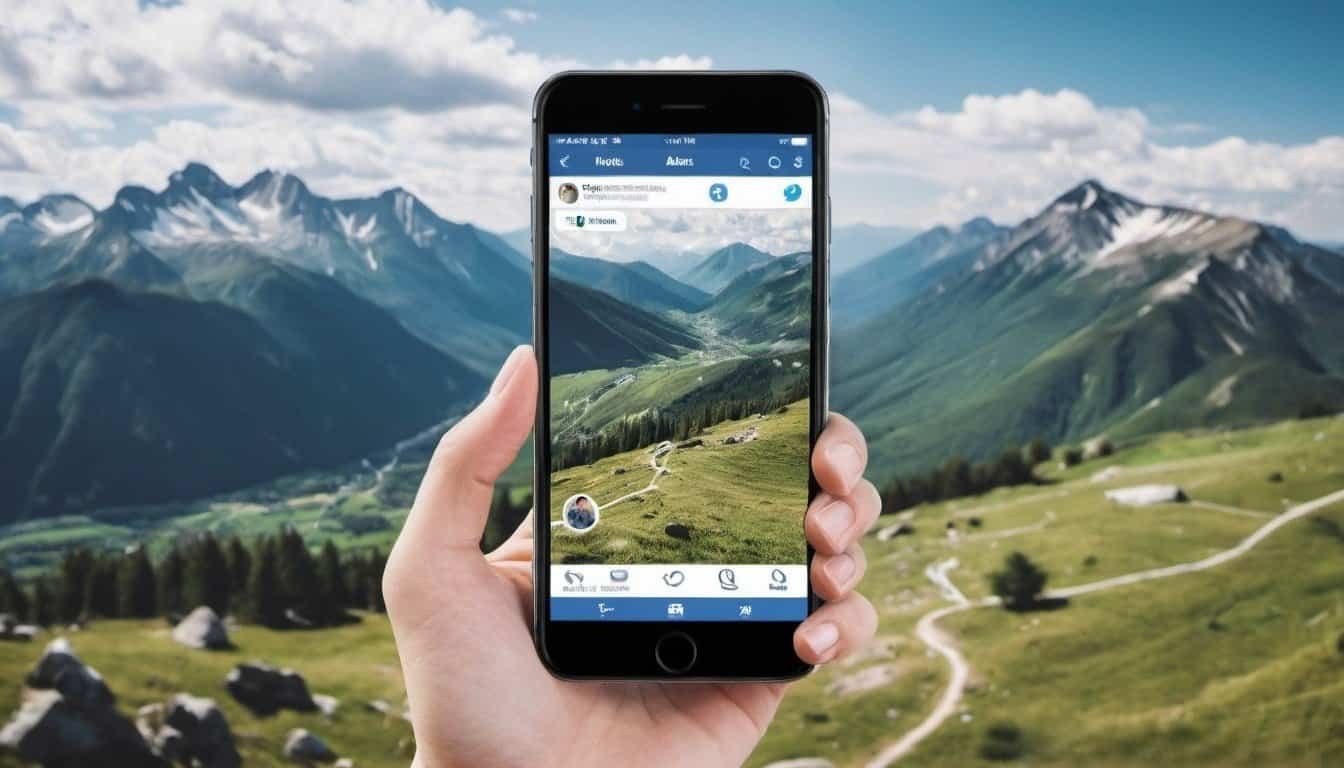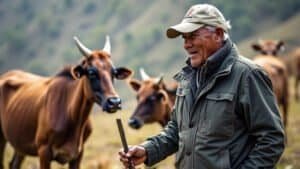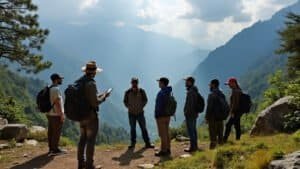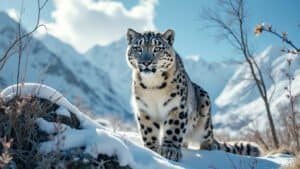Introduction
Social media has become an essential tool in wildlife conservation, providing a platform to reach millions of people globally. When it comes to snow leopards, a species facing numerous threats, social media can play a crucial role in raising awareness, mobilizing support, and driving conservation efforts
This article will explore the most effective social media platforms for promoting snow leopard conservation, the impact of hashtags, the role of influencers, and the power of visual content. We’ll also delve into successful case studies and how to build engaged communities that support snow leopard conservation
Best Social Media Platforms for Snow Leopard Conservation
Social media offers an unprecedented opportunity to reach a global audience and engage them in wildlife conservation efforts. For snow leopard conservation, selecting the right platform is essential to maximize impact and visibility
Different social media platforms offer unique features and audience demographics that can be leveraged to spread awareness, encourage participation, and mobilize resources
Top Platforms for Wildlife Advocacy
The first step in promoting snow leopard conservation on social media is identifying the most effective platforms for reaching target audiences
Among the top contenders, Instagram, Facebook, and Twitter stand out due to their vast user bases and diverse features:
Instagram: Known for its visual-centric approach, Instagram is ideal for sharing stunning images and videos of snow leopards and their natural habitats. Its popularity among younger audiences and influencers makes it a powerful tool for driving engagement and raising awareness
Instagram Stories and Reels, in particular, allow conservation organizations to share real-time updates and behind-the-scenes content, fostering a more personal connection with followers
Facebook: With its extensive reach and diverse user demographic, Facebook is a versatile platform for snow leopard conservation. It allows for detailed posts, community building through groups, and fundraising through integrated donation tools
Facebook’s ability to create events and target specific audiences through ads makes it an effective platform for organizing conservation campaigns and educational initiatives
Twitter (now known as X): Twitter’s fast-paced nature and emphasis on real-time updates make it an excellent platform for disseminating news about snow leopard conservation efforts. The platform’s hashtag culture can help amplify messages and connect with global conservation communities
Twitter threads and chats also provide a space for in-depth discussions and Q&A sessions with experts, further educating the public about the importance of snow leopard conservation
Key Features That Benefit Conservation Efforts
Each social media platform offers specific features that can enhance snow leopard conservation campaigns:
Instagram’s Visual Appeal: The platform’s focus on high-quality images and videos helps capture the beauty of snow leopards and their habitats, making it easier to attract attention and generate empathy. Features like “Swipe Up” in Stories can direct users to informative websites or donation pages
Facebook’s Community Building: Facebook Groups allow like-minded individuals to connect and discuss conservation topics in a dedicated space. Live Streams and Watch Parties on Facebook can host virtual events, like expert talks or live feeds from snow leopard habitats, fostering a sense of community and urgency
Twitter’s Hashtag Potential: Hashtags like #SaveTheSnowLeopard can trend and raise awareness quickly. Twitter Moments can compile the most significant tweets and updates about ongoing conservation efforts, providing a curated experience for users
Platform-Specific Strategies for Engagement
To effectively use these platforms for snow leopard conservation, tailored strategies are necessary:
On Instagram: Posting regularly with a consistent visual theme related to snow leopards and their ecosystems can build a dedicated following. Collaborating with wildlife photographers and influencers can extend the reach. Additionally, interactive features like polls and Q&A in Stories engage followers and educate them on critical conservation issues
On Facebook: Creating a dedicated page or group for snow leopard conservation provides a hub for all related content. Regular updates, shared articles, and engaging posts can keep the community informed and active. Hosting online fundraisers and events can also galvanize support and raise essential funds for conservation projects
On Twitter: Using targeted hashtags and participating in Twitter chats related to wildlife conservation can help build a network of supporters and experts. Retweeting relevant content and engaging with followers through replies and direct messages can sustain interest and encourage more active participation in conservation efforts
By leveraging the unique strengths of Instagram, Facebook, and Twitter, conservationists can maximize the impact of their efforts to protect snow leopards. These platforms not only help raise awareness but also create a global community of supporters who can contribute to the cause in various ways, from spreading the word to making direct donations
The Power of Hashtags in Snow Leopard Conservation
Hashtags have become a powerful tool in social media campaigns, particularly in wildlife conservation. For snow leopard conservation, using effective hashtags can significantly enhance visibility, unify efforts across platforms, and mobilize a global audience
Hashtags create a way for users to discover, share, and engage with content related to snow leopards, amplifying the reach and impact of conservation messages
Creating Effective Hashtags
An effective hashtag is simple, memorable, and relevant to the cause. For snow leopard conservation, it’s essential to create hashtags that resonate with both the target audience and the broader community of social media users
Examples include #SaveTheSnowLeopard, #SnowLeopardConservation, and #ProtectTheGhostOfTheMountain. These hashtags are short, specific, and invoke a sense of urgency, making them more likely to be shared widely
To maximize the effectiveness of hashtags, it’s important to:
Keep it Short and Relevant: A concise hashtag is easier to remember and use. For instance, #SaveTheSnowLeopard is straightforward and immediately communicates the purpose of the campaign
Be Unique Yet Universal: While the hashtag should be unique to the campaign, it should also be broad enough to be understood by a global audience. Avoid overly niche terms that might not be widely recognized
Incorporate Keywords: Using keywords related to conservation, wildlife, and snow leopards ensures that the hashtag is relevant and can be easily found by users searching for those terms
Examples of Successful Hashtag Campaigns
Several conservation campaigns have successfully used hashtags to create global movements and raise awareness for endangered species, including snow leopards. These examples offer valuable lessons for crafting effective snow leopard conservation campaigns:
#EndangeredSpeciesDay: This hashtag is used annually to raise awareness about endangered species around the world, including snow leopards. Conservation organizations and individuals use it to share facts, images, and stories about various species, creating a concentrated burst of awareness on social media
#BigCatWeek: Promoted by National Geographic, this hashtag celebrates big cats like snow leopards, tigers, and lions. The campaign engages millions of users through stunning photography, educational content, and calls to action to support conservation efforts
#WildForLife: Launched by the United Nations, this campaign encourages users to choose a species to protect and use the hashtag to share their commitment. The hashtag has been used by millions, contributing to global conservation awareness
These campaigns demonstrate the power of a well-crafted hashtag to galvanize global support and action. By studying these examples, snow leopard conservationists can craft hashtags that resonate and inspire similar levels of engagement
How to Use Hashtags to Increase Visibility
To effectively use hashtags in snow leopard conservation efforts, it’s crucial to follow a strategic approach:
Integrate Hashtags in All Posts: Consistently use the chosen hashtags in all related posts across social media platforms. This helps build a recognizable and unified brand for the conservation campaign
Combine Hashtags with Visual Content: Pairing hashtags with compelling visuals, such as photographs or videos of snow leopards, increases the likelihood of shares and engagement. Visual content catches the eye and draws users into the conversation, making the hashtags more impactful
Engage with Hashtag Campaigns: Participate in broader conservation hashtag campaigns to tap into larger audiences. For example, using #WorldWildlifeDay alongside a dedicated snow leopard hashtag can link the conservation message to a global event, increasing visibility
Encourage User Participation: Invite followers to use the hashtag in their posts, whether it’s sharing their favorite snow leopard facts, art, or experiences related to wildlife conservation. User-generated content helps spread the message organically and creates a sense of community around the cause
Monitor Hashtag Performance: Use social media analytics tools to track the performance of hashtags. Metrics such as reach, engagement, and the number of posts using the hashtag can provide insights into the campaign’s effectiveness and areas for improvement
By harnessing the power of hashtags, snow leopard conservation campaigns can achieve greater visibility and engagement on social media. Effective hashtags not only help raise awareness but also foster a sense of community and collective action, which is crucial for the success of conservation efforts
Influencer Contributions to Snow Leopard Conservation
Influencers have become key players in spreading awareness and driving action on social media. Their ability to reach vast audiences and shape public opinion makes them valuable allies in snow leopard conservation efforts
By leveraging their platforms, influencers can amplify conservation messages, engage new audiences, and inspire tangible support for protecting snow leopards
Why Influencers Matter in Conservation
Influencers have a unique ability to connect with their followers on a personal level, making them effective advocates for causes they care about. In the context of snow leopard conservation, influencers can:
Raise Awareness: Influencers can introduce their followers to the plight of snow leopards, often reaching people who might not be aware of the species’ endangered status. Through posts, stories, and videos, they can share important information about the threats snow leopards face, such as habitat loss, poaching, and climate change
Drive Engagement: Influencers can encourage their followers to take action, whether it’s by sharing content, participating in conservation campaigns, or donating to organizations that protect snow leopards. Their endorsement can lend credibility to the cause and motivate others to get involved
Fundraise for Conservation: Many influencers use their platforms to support fundraising efforts, often partnering with conservation organizations to raise money for specific projects. By hosting charity events, auctions, or donation drives, influencers can mobilize financial resources that are critical for conservation initiatives
Case Studies of Influencer-Led Campaigns
Several successful conservation campaigns have highlighted the impact influencers can have in promoting wildlife protection, including efforts focused on snow leopards:
Leonardo DiCaprio Foundation: Actor Leonardo DiCaprio, a well-known environmental advocate, has used his platform to support numerous wildlife conservation efforts, including snow leopard protection. Through his foundation and social media channels, DiCaprio has raised millions of dollars and brought global attention to the threats faced by endangered species
Natasha Daly and National Geographic’s #WildlifeWednesday: Journalist and influencer Natasha Daly regularly uses her social media presence to promote wildlife conservation. Her involvement in National Geographic’s #WildlifeWednesday campaign, which often features snow leopards, has helped raise awareness about the species and the challenges they face
Paul Nicklen and SeaLegacy: Renowned photographer Paul Nicklen co-founded SeaLegacy, an organization that uses visual storytelling to inspire action for ocean and wildlife conservation. His stunning images of snow leopards and other wildlife, shared on platforms like Instagram, have reached millions of followers, driving awareness and support for conservation initiatives
These case studies demonstrate the profound impact influencers can have on conservation efforts. By leveraging their reach and credibility, influencers can significantly enhance the visibility and effectiveness of snow leopard conservation campaigns
How to Partner with Influencers for Conservation
Partnering with influencers requires a strategic approach to ensure that the collaboration aligns with the goals of snow leopard conservation. Here are key steps to successfully engage influencers:
Identify the Right Influencers: Look for influencers who are genuinely passionate about wildlife conservation and have a track record of supporting environmental causes. Their authenticity will resonate more with their audience and lend greater credibility to the campaign
Build Mutually Beneficial Relationships: Collaborate with influencers who see value in the partnership beyond financial compensation. Offer them opportunities to be directly involved in conservation activities, such as visiting snow leopard habitats or participating in fieldwork, which they can then share with their followers
Develop Clear Campaign Objectives: Clearly define what you hope to achieve through the partnership. Whether it’s raising a certain amount of funds, increasing awareness, or driving specific actions, having clear goals will guide the influencer’s content and ensure alignment with the conservation mission
Provide Resources and Support: Equip influencers with accurate information, compelling visuals, and talking points about snow leopards. This helps them create content that is both engaging and informative. Additionally, offering creative freedom can result in more authentic and impactful posts
Measure Impact: After launching the campaign, track key performance indicators (KPIs) such as engagement rates, hashtag use, and donation levels. This data can help assess the campaign’s success and inform future collaborations with influencers
By partnering with the right influencers, snow leopard conservation organizations can tap into new audiences and amplify their message on a global scale. Influencers bring not only their reach but also their ability to inspire and mobilize their followers, making them invaluable partners in the fight to protect snow leopards
Using Visual Content to Advocate for Snow Leopards
Visual content is one of the most powerful tools in social media advocacy, especially when it comes to conservation
Images and videos can capture the beauty and majesty of snow leopards, evoke emotional responses, and inspire action. By leveraging visual storytelling, conservationists can raise awareness, educate the public, and garner support for snow leopard conservation efforts
The Importance of Visual Storytelling
Visual storytelling allows conservationists to convey complex messages in a way that is easily digestible and emotionally engaging
In the case of snow leopards, which are elusive and live in remote mountainous regions, visual content helps bring their world closer to the global audience:
Eliciting Emotional Responses: Powerful images and videos of snow leopards in their natural habitat, or facing threats like poaching, can evoke empathy and concern. These emotions are critical in motivating people to care about conservation and take action
Simplifying Complex Issues: Conservation challenges such as habitat loss and climate change can be difficult to convey through text alone. Visual content can illustrate these issues more clearly, showing, for example, the shrinking habitats of snow leopards or the impact of human activities on their environment
Creating Memorable Campaigns: Memorable visuals are more likely to be shared, discussed, and remembered, extending the reach of conservation messages. Iconic images of snow leopards, such as those captured by renowned wildlife photographers, can become symbols of the conservation movement
Types of Content That Resonate with Audiences
Different types of visual content can be used to advocate for snow leopard conservation, each with its own strengths in capturing audience attention and driving engagement:
Photography: High-quality photographs of snow leopards, their habitats, and conservation efforts are highly shareable and can be used across various platforms. Close-up shots of snow leopards in the wild can highlight their beauty and the need to protect them, while images showing the impact of conservation efforts can provide hope and encourage support
Videos: Short videos documenting the lives of snow leopards, conservation challenges, or success stories can be incredibly effective. Videos have the advantage of combining visuals with sound and narration, making them ideal for storytelling. For example, a video showing a day in the life of a snow leopard or the work of conservationists can be both informative and emotionally compelling
Infographics: Infographics can break down data and facts about snow leopards and their conservation in a visually appealing way. They are particularly useful for social media platforms where users prefer quick, easy-to-digest content. Infographics can cover topics like the population status of snow leopards, the threats they face, and how people can help
Live Streams: Live streaming events, such as talks with conservation experts, Q&A sessions, or live feeds from snow leopard habitats, offer real-time engagement opportunities. These events can attract large audiences and allow direct interaction, making them a valuable tool for raising awareness and fostering a sense of community
Tools for Creating Engaging Visual Content
Creating compelling visual content for snow leopard conservation requires the right tools and resources. Here are some tools that can help:
Photography and Videography Tools: High-quality cameras and drones are essential for capturing stunning images and videos of snow leopards in the wild. Editing software like Adobe Photoshop and Premiere Pro can enhance and polish visual content before it’s shared on social media
Graphic Design Software: Tools like Canva, Adobe Illustrator, and Inkscape allow conservationists to create professional-looking infographics, posters, and social media graphics. These tools are user-friendly and provide templates that can be customized to fit the campaign’s needs
Social Media Management Tools: Platforms like Hootsuite, Buffer, and Later help schedule and manage the distribution of visual content across various social media channels. These tools also offer analytics to track engagement and adjust strategies based on what resonates most with the audience
Storytelling Platforms: Websites like Exposure and Steller provide templates for creating visually-driven stories that can be shared on social media. These platforms are particularly useful for combining images, videos, and text into a cohesive narrative that engages viewers from start to finish
By using these tools effectively, conservationists can create visual content that not only educates but also inspires action. Engaging and high-quality visuals are more likely to be shared and remembered, making them a critical component of any snow leopard conservation campaign
Case Studies: Successful Conservation Campaigns on Social Media
Examining successful conservation campaigns can provide valuable insights and inspiration for those working to protect snow leopards. These case studies highlight how social media has been used effectively to raise awareness, mobilize communities, and drive action for wildlife conservation
Overview of Impactful Campaigns
Several conservation campaigns have leveraged social media to create significant impact, not only for snow leopards but also for other endangered species
These campaigns demonstrate the potential of social media to reach global audiences and generate real-world results:
#SaveTheTigers Campaign: This global campaign aimed to raise awareness about the dwindling tiger population and encourage action to protect these big cats. By utilizing powerful imagery, celebrity endorsements, and interactive social media challenges, the campaign reached millions of people worldwide
The success of #SaveTheTigers shows how a focused, well-coordinated social media campaign can lead to increased public awareness and support for conservation
#RhinoCoin Initiative: The #RhinoCoin campaign used social media to support rhino conservation by creating a digital currency that could be used to fund anti-poaching efforts
The campaign attracted widespread attention due to its innovative approach and the use of influencers to spread the message. It also demonstrated how social media can be used to drive donations and support for conservation in a creative and engaging way
#ProjectC.A.T. (Conserving Acres for Tigers): Launched by Discovery Communications in partnership with World Wildlife Fund (WWF), this campaign aimed to secure habitats for tigers in India and Bhutan. The campaign leveraged Discovery’s extensive social media presence to reach millions of viewers with messages about the importance of habitat conservation
#ProjectC.A.T. successfully raised awareness and funds to protect critical tiger habitats, demonstrating the power of combining traditional media with social media outreach
Lessons Learned from Successful Efforts
The success of these campaigns offers several key lessons that can be applied to snow leopard conservation:
Clear and Compelling Messaging: Successful campaigns have clear, focused messages that resonate with the audience. Whether it’s saving tigers, rhinos, or snow leopards, the message should be easy to understand and emotionally engaging
Effective storytelling, backed by facts and compelling visuals, helps make the cause relatable and urgent
Leveraging Influencers and Celebrities: Many successful campaigns have partnered with influencers and celebrities who have large, engaged followings. These individuals can amplify the campaign’s message, reaching audiences that might not otherwise engage with conservation issues
For snow leopard conservation, partnering with wildlife photographers, environmentalists, and public figures who care about wildlife can significantly boost visibility
Interactive and Engaging Content: Campaigns that encourage audience participation tend to be more successful. Interactive content, such as quizzes, challenges, or user-generated content campaigns, helps create a sense of involvement and ownership among supporters
For snow leopard conservation, challenges like “Spot the Snow Leopard” photo contests or fundraising drives with social media milestones can engage and motivate followers
Multi-Platform Strategy: Successful campaigns often use a multi-platform approach, spreading their message across different social media channels to reach a broader audience
Each platform has its own strengths, and tailoring content to fit the platform—whether it’s visual-heavy Instagram, discussion-focused Twitter, or community-driven Facebook—can enhance the campaign’s effectiveness
Adapting Successful Strategies for Snow Leopards
To create a successful social media campaign for snow leopard conservation, the strategies used in these case studies can be adapted and applied:
Craft a Strong, Unified Message: Focus the campaign on a specific aspect of snow leopard conservation, such as habitat protection, anti-poaching efforts, or the importance of biodiversity. The message should be clear and supported by striking visuals of snow leopards in the wild
Partner with Key Influencers: Identify and collaborate with influencers who are passionate about wildlife conservation. These could include photographers, environmental activists, and celebrities who have a genuine interest in protecting endangered species. Their endorsement can bring credibility and attract a larger audience to the campaign
Engage the Audience with Interactive Content: Create opportunities for followers to get involved, such as sharing their own wildlife photos, participating in virtual events, or contributing to conservation efforts through donations. User-generated content can help spread the campaign’s message organically and create a sense of community
Utilize Multiple Social Media Platforms: Develop content that is tailored to different platforms, ensuring the campaign reaches as wide an audience as possible. Use Instagram for visually-driven posts, Twitter for real-time updates and discussions, and Facebook for community building and detailed information sharing
By drawing on the successes of past campaigns, snow leopard conservation efforts can be more strategic and impactful on social media. These campaigns demonstrate that with the right approach, social media can be a powerful tool for wildlife conservation, capable of mobilizing global support and driving meaningful action
Community Engagement in Snow Leopard Conservation via Social Media
Engaging communities through social media is essential for building long-term support for snow leopard conservation. By fostering a sense of connection and collective responsibility, conservation organizations can mobilize individuals and groups to take meaningful action
Social media platforms provide the perfect space for creating and nurturing these communities, offering tools that encourage interaction, participation, and sustained involvement
Building Online Conservation Communities
Creating an online community focused on snow leopard conservation involves more than just sharing content; it’s about building a space where people feel connected to the cause and to each other
Here are key strategies for building such a community:
Create Dedicated Spaces: Platforms like Facebook Groups or Reddit communities are ideal for gathering people who are passionate about snow leopard conservation. These spaces allow members to share their thoughts, ask questions, and participate in discussions. A dedicated group or page can become a hub for all things related to snow leopards, from sharing the latest research to organizing local events
Foster a Welcoming Environment: Encourage a positive and inclusive atmosphere where all members feel comfortable sharing their ideas and experiences. Moderation is key to maintaining a respectful and productive community. Set clear guidelines for interaction to ensure discussions remain focused and respectful
Regularly Share Engaging Content: Keep the community active by regularly posting updates, articles, photos, and videos related to snow leopard conservation. Highlight the latest news, research findings, and success stories to keep members informed and motivated. Interactive content, like polls or quizzes, can also engage members and spark conversation
Encouraging User-Generated Content
User-generated content (UGC) is a powerful way to build community engagement. By encouraging followers to contribute their own content, such as photos, videos, or stories, you create a more interactive and personal experience that strengthens their connection to the cause:
Photo and Video Contests: Organize contests that invite members to share their best wildlife photos or videos, especially those related to snow leopards. Contests can be themed, such as capturing “The Spirit of the Snow Leopard” or showcasing “Snow Leopards in Art.” Winners can be featured on the organization’s social media channels, offering recognition and encouraging more participation
Story Sharing: Invite community members to share their personal experiences or stories related to snow leopards or wildlife conservation. These stories can be shared as posts or as part of a larger campaign, helping to humanize the conservation effort and create a more personal connection
Hashtag Campaigns: Encourage followers to use specific hashtags when posting about snow leopards. This not only helps in tracking and curating user content but also builds a broader movement across social media platforms. A campaign like #MySnowLeopardStory could inspire people to share their experiences, art, or actions taken in support of conservation
How to Foster Long-Term Engagement
Sustaining community engagement over the long term is crucial for the ongoing success of snow leopard conservation efforts. Here are strategies to keep the momentum going:
Organize Regular Events: Virtual events, such as webinars, Q&A sessions with experts, or live-streamed visits to snow leopard habitats, keep the community engaged and provide ongoing learning opportunities. These events can also serve as fundraising opportunities or calls to action
Celebrate Milestones and Successes: Regularly update the community on the impact of their contributions, whether it’s through funds raised, petitions signed, or conservation achievements. Celebrating these milestones together helps reinforce the community’s sense of accomplishment and shared purpose
Offer Opportunities for Deeper Involvement: Provide avenues for community members to take more active roles in conservation efforts. This could include volunteer opportunities, advocacy campaigns, or ambassador programs where members can represent the organization and its mission
Personalize Communication: Engage with community members on a more personal level by responding to comments, acknowledging contributions, and creating tailored content that reflects the community’s interests and concerns. Personal interaction fosters a stronger sense of belonging and loyalty
Provide Educational Resources: Keep the community informed with up-to-date educational content about snow leopards and conservation practices. Offering free resources, such as downloadable guides, webinars, or infographics, adds value to the community and keeps members engaged
By effectively building and maintaining an engaged online community, snow leopard conservation organizations can create a network of passionate supporters who are invested in the cause
These communities not only amplify the reach of conservation messages but also provide a platform for collective action, ensuring that the efforts to protect snow leopards continue to grow and thrive
Conclusion
Social media has emerged as a powerful tool in the fight to protect endangered species like snow leopards. By strategically leveraging platforms such as Instagram, Facebook, and Twitter, conservationists can reach a global audience, raise awareness, and drive meaningful action
Hashtags, influencer partnerships, and visual content all play critical roles in amplifying conservation messages and engaging supporters. Moreover, building and nurturing online communities ensures sustained involvement and support, creating a network of advocates dedicated to preserving snow leopards
Through these combined efforts, social media can significantly contribute to the survival of these magnificent creatures and the broader conservation movement








